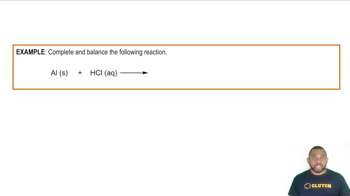Ch.22 - Chemistry of the Nonmetals

Brown15th EditionChemistry: The Central ScienceISBN: 9780137542970Not the one you use?Change textbook
Chapter 22, Problem 66
Complete the exercises below. Complete and balance the following equations: b. NaHCO₃ (g) + H⁺ (aq) →
 Verified step by step guidance
Verified step by step guidance1
Identify the reactants and products in the chemical equation. Here, the reactants are sodium bicarbonate (NaHCO₃) and a hydrogen ion (H⁺).
Determine the products of the reaction. When NaHCO₃ reacts with H⁺, it typically forms carbon dioxide (CO₂), water (H₂O), and sodium ion (Na⁺).
Write the unbalanced chemical equation: NaHCO₃ (g) + H⁺ (aq) → Na⁺ (aq) + CO₂ (g) + H₂O (l).
Balance the chemical equation by ensuring that the number of atoms of each element is the same on both sides of the equation. Start by balancing the elements that appear in only one reactant and one product.
Check the charges on both sides of the equation to ensure they are balanced. Adjust coefficients as necessary to achieve charge balance, ensuring the equation is both mass and charge balanced.
Key Concepts
Here are the essential concepts you must grasp in order to answer the question correctly.
Acid-Base Reactions
Acid-base reactions involve the transfer of protons (H⁺ ions) between reactants. In this case, NaHCO₃, or sodium bicarbonate, acts as a base that can accept a proton from an acid, represented by H⁺. Understanding this concept is crucial for predicting the products of the reaction and balancing the equation.
Recommended video:
Guided course

Acid-Base Reaction
Balancing Chemical Equations
Balancing chemical equations ensures that the number of atoms for each element is the same on both sides of the equation, adhering to the law of conservation of mass. This involves adjusting coefficients in front of compounds to achieve balance. For the given reaction, identifying the products and ensuring the equation is balanced is essential.
Recommended video:
Guided course

Balancing Chemical Equations
Products of Sodium Bicarbonate Reaction
When sodium bicarbonate reacts with an acid, it typically produces carbon dioxide (CO₂), water (H₂O), and a salt. In this case, the reaction with H⁺ will yield carbonic acid (H₂CO₃), which can decompose into CO₂ and H₂O. Recognizing these products is vital for completing and balancing the equation correctly.
Recommended video:
Guided course

Production of Hydrogen Example
Related Practice
